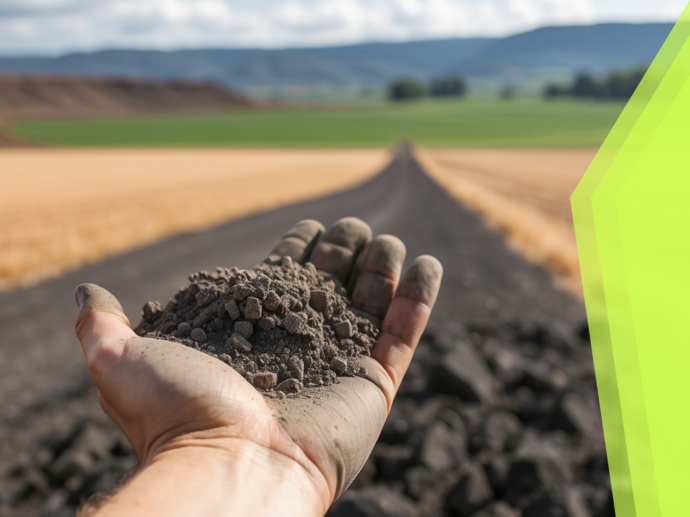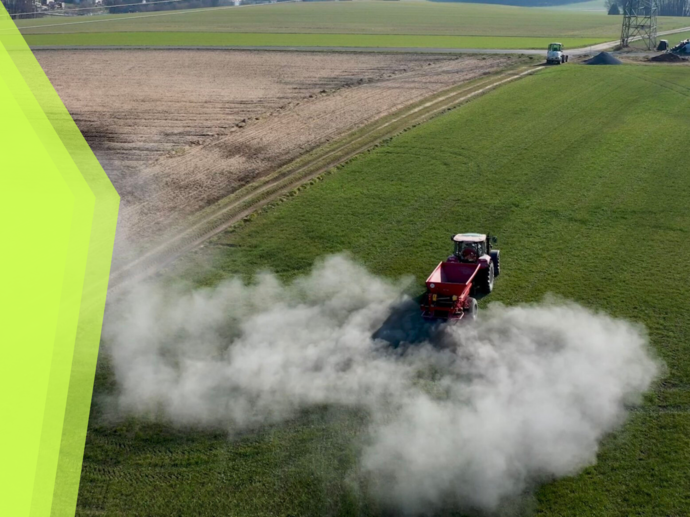Discover the science behind our CO2 removal approach.
reverce builds its operations on the fundamental research of its scientific partners. To learn more about the research activities of our partner Carbon Drawdown Initiative, click on the button below.
Natural rock weathering
As part of the geologic carbon cycle, the weathering of rocks regulates the concentration of carbon dioxide in the Earth's atmosphere over millions of years.
When rain falls, it dissolves some of the carbon dioxide in the atmosphere to form carbonic acid (H2CO3). When it lands on rocks, chemical reactions take place that weather the rocks and convert carbonic acid to bicarbonate ions (HCO3−). In this form, the bound carbon flows through groundwater and rivers to the ocean. There, the bicarbonate ions stay for up to 100 000 years before being transformed into carbonate sediments and then limestone. In this form, the carbon remains locked away from the atmosphere for millions of years, making it permanent in human terms.
Unfortunately, this natural mechanism is far too slow to balance human-caused carbon dioxide emissions and to prevent the accelerating accumulation of carbon in the atmosphere.

Enhanced rock weathering
Enhanced rock weathering (ERW) is a developing technology to accelerate the natural process of rock weathering to a level that can help mitigate anthropogenic climate change.
This is done by crushing and pulverizing suitable rocks to maximize the surface area for weathering reactions, and by systematically incorporating the material into the soil, where much higher CO2 concentrations facilitate the formation of carbonic acid and the weathering of the rock dust.
With the right combination of soil and rock, carbon removal can be achieved in years to decades, as opposed to the millions of years required for the natural process.
Our process
We work with farmers and provide them with rock material tailored to their fields. The composition varies depending on location and soil needs. Farmers receive co-benefits from the distribution of the rock mix, as the natural minerals contribute to healthier plants and higher yields.
We conduct extensive measurements in the field and with soil samples in our greenhouses to measure the amount of carbon removed.
Based on this data, we generate carbon removal credits that companies, governments and other organizations can use to offset their residual emissions in the most reliable way possible, helping them to reduce their carbon footprint.


Measurement, reporting and verification (MRV)
Compared to other carbon dioxide removal technologies, the amount of carbon removed with ERW is not easily measurable. ERW occurs through complex interactions of chemical, physical and biological processes from the point of application to the ocean.
Currently, there exists no robust MRV approach that can accurately measure the amount of CO2 removed from the atmosphere in the field. However, there are ways to calculate this theoretically and clearly account for uncertainties by applying safety margins according to the level of uncertainty. reverce is building an ERW methodology that takes into account the current scientific knowledge to calculate a realistic amount of carbon dioxide removed.
At the same time, we are pioneering a robust and transparent MRV approach. It combines on-site soil analyses and CO2 efflux measurements with greenhouse experiments. These experiments replicate the conditions to achieve a comprehensive assessment of the amount of carbon dioxide removed. This procedure provides the most detailed assessment across any ERW projects available today. Although a holistic and robust MRV does not yet exist, our approach provides the most transparent and scientifically sound way to quantify the ERW effect.
.
The formulas
Formation of carbonic acid
CO2 + H2O → H2CO3
Carbonic acid reacts with the added rock dust, dissolving its minerals and producing bicarbonate ions
e.g., for olivine as an example for a mineral in silicate rock dust (basalt)
Mg2SiO4 + 4 H2CO3 → 2 Mg2+ + 4 HCO3- + H4SiO4
How rocks will safe the world
References
-
Baek, S. H., et al. (2023). Impact of climate on the global capacity for enhanced rock weathering on croplands. Earth’s Future, 11(8), e2023EF003698. https://doi.org/10.1029/2023EF003698.
-
Beerling, D. J., et al. (2020). Potential for large-scale CO2 removal via enhanced rock weathering with croplands. Nature, 583(7815), 242–248. https://doi.org/10.1038/s41586-020-2448-9.
-
Campbell, J. S., Bastianini, L., Buckman, J., Bullock, L., Foteinis, S., Furey, V., Hamilton, J., Harrington, K., Hawrot, O. K., Holdship, P., Knapp, W. J., Maesano, C. N., Mayes, W. M., Pogge von Strandmann, P. A. E., Reershemius, T., Rosair, G. M., Sturgeon, F., Turvey, C., Wilson, S., & Renforth, P. (2023). Measurements in Geochemical Carbon Dioxide Removal. Heriot-Watt University. https://doi.org/10.17861/2GE7-RE08.
-
Deng, H. et al. (2023). The environmental controls on efficiency of enhanced rock weathering in soils. Scientific Reports, 13(1), 9765. https://doi.org/10.1038/s41598-023-36113-4.
-
Goll, D. S. et al. (2021). Potential CO2 removal from enhanced weathering by ecosystem responses to powdered rock. Nature Geoscience, 14(8), 545–549. https://doi.org/10.1038/s41561-021-00798-x.
-
Hartmann, J. et al. (2013). Enhanced chemical weathering as a geoengineering strategy to reduce atmospheric carbon dioxide, supply nutrients, and mitigate ocean acidification. Reviews of Geophysics, 51(2), 113–149. https://doi.org/10.1002/rog.20004.